| | | |
Attack on Ukraine
A historical turning pointThe Russian invasion of Ukraine is causing a humanitarian catastrophe in the center of Europe. The war is also affecting innocent civilians, many of whom are fleeing the violence. Their country, but also our common values of freedom and peace, are being shaken. Russia’s attack is in many respects a turning point with long-term political and economic consequences. Every effort must be made to mitigate the hardship and to end the war as quickly as possible. The determined and concerted action of the international community is necessary to achieve this. The daily work of the Lufthansa Group contributes to international understanding. We build bridges and connect people, cultures and economies. Our airlines previously offered around 100 weekly flights to Russia and Ukraine. These connections have been suspended until further notice. Moreover, the Lufthansa Group airlines are no longer flying over the airspaces of both countries. Political leadership, civil society and companies can each provide meaningful support in various ways. Lufthansa Cargo, for example, is involved in transporting urgently needed relief supplies to Poland. When if necessary, our airlines offer additional flight capacities for travelers people in need. Help alliance, the aid organization of the Lufthansa Group, also responded quickly to the humanitarian crisis: it supports local aid initiatives at numerous Lufthansa Group locations. In addition, help alliance collects donations for the German Red Cross to support the people affected. The war and the imposed sanctions also affect the Lufthansa Group financially. The impact will depend on the duration of the war and can therefore not be predicted in a reliable way. This applies to the increase in fuel prices as well as to the partially changed flight routes to Asia. Overall, re-routing currently affects less than one percent of our available seats. This is mainly caused by the already depleted passenger traffic volumes due to COVID. The costs associated with re-routing will increase once traffic volumes normalize as the pandemic subsides. The Lufthansa Group complies with the current sanctions that have been imposed. In Russia, it has stopped all maintenance, repair and overhaul services for customers and has suspended ticket sales of airlines belonging to the Lufthansa Group. | |
| | | |
Aviation Alliance Fit for 55
Ensure Fair Competition and Avoid Carbon LeakageIt’s no secret that airlines and airports do not always see eye to eye. But when it comes to “Fit for 55,” European network carriers and hub airports are united: the EU climate protection package could significantly weaken their position in global competition. They call for an international level playing field with competitors from the Middle East, China, the USA and Turkey. | |
| | | | Traffic flows are shifting
More and more passengers are changing planes in Istanbul, Dubai or Doha on their way to Asia or Africa. Germany is losing its former role as a transfer country. Passenger flows from Germany to Africa and Asia 2010 vs. 2019 via: 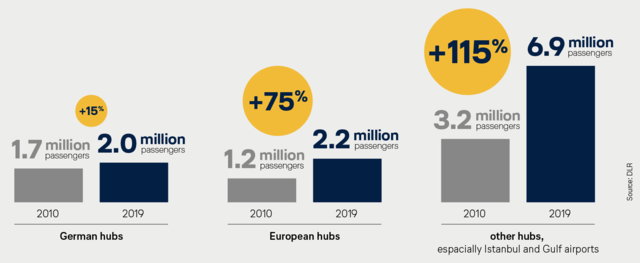
| |
| | | | European network airlines and hubs connect Europe to the world, secure international economic relations, and supply chains. To be successful as a global player, Europe needs a strong aviation industry. The indispensable value of flying is countered by its impact on the environment. Therefore, it is right that with “Fit for 55” the EU is also pursuing ambitious climate targets for aviation. Hubs in competition
Achieving these objectives will require a climate policy that effectively reduces emissions, avoids carbon leakage and ensures fair competition. This is precisely where the Aviation Alliance Fit for 55 sees urgent need for improvement. Around 20 hub airports and network carriers, including the airlines belonging to the Lufthansa Group, have joined forces in the new alliance. They fear significant competitive disadvantages if the current plans are implemented. This is because, unlike low-cost airlines that only fly in Europe, they compete with airlines and hubs from the Bosporus or the Persian Gulf, which do not have to meet the same climate protection requirements. The criticism: Both the tightening of the European Emissions Trading System (ETS), the planned blending mandate for sustainable – but also substantially more expensive – aviation fuel unilaterally increase the costs of long-haul flights with transfers at EU hubs. Hubs close to the EU, such as Istanbul or Dubai, as well as tourist regions outside the EU, stand to benefit. This is because transferring at non-EU hubs would become comparatively cheaper, with the resulting effect that CO2 emissions merely shift abroad, rather than actually being saved. | |
| | | | One-sided EU cost burden – also to the detriment of shorter and more climate-friendly air routes 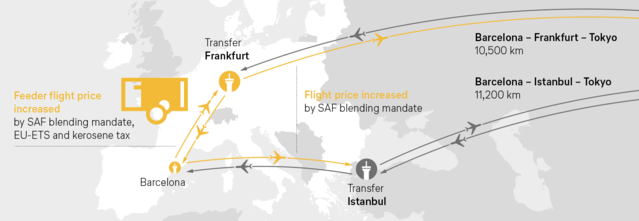
| |
| | | | One-sided cost burden
Even if low-cost airlines and recently even Transport & Environment try to downplay the carbon leakage risk, analyses clearly show how much the Fit for 55 measures will widen the price gap and disadvantage Europe. Two examples: While tickets at Frankfurt Airport would become more than 25 percent more expensive by 2035, the cost increase in Istanbul would be only four percent. As a result, demand in Frankfurt would decline by around 15 percent, while Istanbul could expect growth in passenger numbers. In 2040, the additional costs incurred by Fit for 55 for a trip from Stockholm to Bangkok via Munich would be three times higher than for the same flight with a change in Istanbul. For certain routes, such as Hamburg-Bangkok, transferring via non-European hubs causes more CO2 emissions, compared to flying via an EU hub. | |
| | | | Fit for 55 for aviation
How to avoid carbon leakage and ensure fair competition. 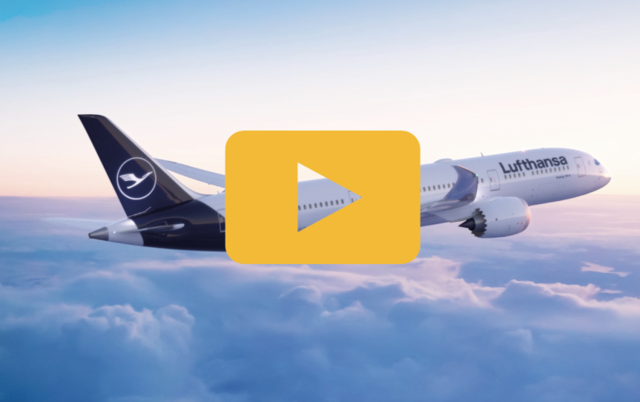
| |
| | | | Europe’s hubs have been under pressure for a whole decade
Such a loss of value creation and connectivity without a positive effect on the climate cannot be the intent nor a side effect of European policy, especially considering that hubs in Germany and Europe have already been under pressure in the years preceding the pandemic. Research from the German Aerospace Center (DLR) shows that more and more passengers are choosing transfers in Istanbul, Dubai or Doha on their way to Asia or Africa. While traffic from Germany to Asia and Africa increased by 73 percent between 2010 and 2019, Germany hardly plays a role as a transfer country (+15 percent). Growth in this market is seen mainly on routes via Istanbul and hubs outside Europe (+115 percent). This trend must not be allowed to continue. On the contrary. The success of European regulation will largely depend on whether we succeed not only in ensuring fair competition within Europe, but also in creating a level playing field with non-European airlines and hubs. | |
| | | | | Aviation Alliance Fit for 55
Currently, 19 hub airports and network carriers, including the airlines of the Lufthansa Group, have joined forces in the new alliance. They fear considerable competitive disadvantages if the current plans are implemented. More at: www.aviationalliance.eu |
| |
| | | |
Connecting the World
Strengthening Efficient HubsFor shorter routes in Europe, direct flights are often the preferred option. Intercontinental travelers, on the other hand, usually connect through a hub airport. The reason: the hub system offers a wide range of long-haul connections that direct flights alone cannot provide. The mix of transfer passengers and regional passengers ensures that the capacities of long-haul aircraft are used in an optimal way – which is ideal from both an economic and an ecological point of view.The airlines of the Lufthansa Group offer their customers a broad network of coordinated long-haul flights via the hubs in Frankfurt, Munich, Zurich, Vienna and Brussels. By bundling passengers from many countries at major airports – who then travel together to their destination in one aircraft – we provide good connectivity at competitive prices. Flying through hub systems is very efficient. To connect twelve cities directly, it takes 66 individual routes. A hub system requires only twelve routes. In addition, this is advantageous regarding climate protection: a high seat load factor in the largest possible aircraft significantly reduces the fuel consumption per passenger. | |
| | | | Munich – San Francisco: passengers from 50 destinations on long-haul aircraft
On October 11, 2019, the LH-458 flight took off from Munich to San Francisco. Of the 278 passengers, over 70 percent started their journey at another airport and transferred to Lufthansa in MUC. 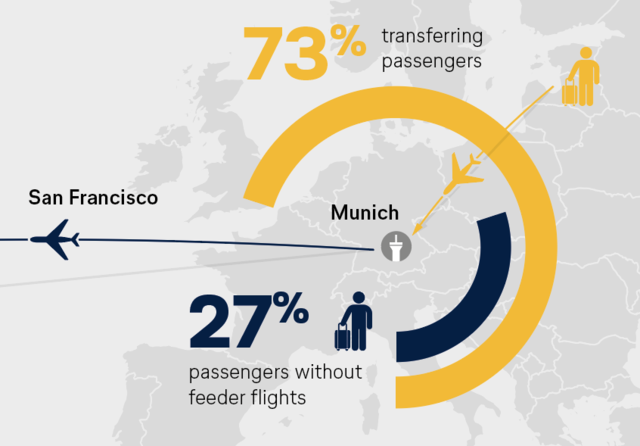
| |
| | | | Airline partnerships secure worldwide connectivity
By cooperating with other international airline partners, the Lufthansa Group can offer additional long-haul connections all over the world and can make good use of capacity. In the Star Alliance, for example, Lufthansa, United Airlines and Air Canada work together in a far-reaching joint venture: On routes between their home countries, the three partners – who always take off from their hubs for transatlantic routes – jointly evaluate capacities and decide who is best suited to operate them. Strengthening the hub system
Through hubs and partnerships, airlines connect Europe to the world. However, more and more transfer traffic is shifting to hubs outside Europe. More travelers are transferring in Dubai, Doha or Istanbul. The “success” of these hubs is made possible by industrial and corporate policies that come at the expense of social and environmental standards. The resulting loss of value creation for EU airlines must not be worsened by EU regulation. This means that climate regulations, such as those currently planned by the Fit for 55 initiative (see previous article), must not unilaterally make flights in and out of the EU more expensive. Otherwise, they will create incentives to fly via non-European hubs (carbon leakage). In Germany, the three parties making up the government have pledged to continue to develop an efficient aviation industry and to advocate for a fair regulatory framework in the context of international competition. Finding balanced solutions will require the engagement not only of the German government but of the entire European Council. | |
| | | | Connecting capitals: Lufthansa partner launches direct flights to U.S. hub
With transfers, the Lufthansa Group connects Brussels, the capital of Europe, with nearly 300 destinations worldwide. From Berlin, passengers can fly to more than 200 destinations with just one transfer. Starting in March, joint venture partner United Airlines will fly directly from the German capital to New York, and starting in May, to Washington for the first time. Both cities are among United’s six U.S. hubs. All flights can also be booked via Lufthansa and feature a Lufthansa flight number. | |
| | | |
Single European Sky
EU Climate Policy Increases Pressure to ActDirect flight routes, more punctuality, fewer emissions – the long-overdue reform of European airspace offers plenty of opportunities. For many years, the European Commission has wanted to implement the so-called Single European Sky (SES). But the project is once again threatened by a stalemate. | |
| | | | Finally realizing the potential for climate protection of the Single European Sky
Fuel savings through shortened flight paths and optimized approach procedure 
| |
| | | | After initial reform efforts failed in 2013, the European Commission presented a revised proposal for a regulation to implement the Single European Sky (SES2+) in September 2020. The need for this had become increasingly evident, following the 2018/2019 capacity crises and the formulation of ambitious climate targets at the EU level. Since last summer, discussions, also known as “trilogues”, have been ongoing between the Commission, the EU Parliament, and the Member States, so far without success. While the Parliament supports large parts of the Commission’s proposal, several Member States are blocking it. The problem then, as now, are concerns about national sovereignty. Until now, air traffic control has been a largely sovereign matter in each country. Currently, more than 60 control centers with different IT systems are responsible for air traffic control throughout Europe. In the future, these are to be harmonized at the European level in the SES. The Member States’ inability to agree on the SES so far does not bode well for the EU’s ambitious climate policy goals. Airlines and passengers are not the only ones who would benefit from shorter flight times and fewer delays. The environment also stands to gain: A more efficient and uniformly structured airspace with optimized flight routes could reduce CO2 emissions in EU airspace by up to 10 %. The long-overdue implementation of the SES would be a real climate protection measure. The negotiations, so far stagnant, need to get moving. Two decisive, but to date hesitant countries have now placed the reform project back on the political agenda. Both Germany and France, the latter having taken over the EU Council presidency at the beginning of the year, have included the implementation of SES2+ in their programs. The objective now is to put the Commission’s proposals into practice, sooner rather than later. Three core tasks lie ahead: - Harmonizing airspace and enabling climate-optimized flight routes: Lufthansa and Germany’s air traffic control are working consistently to guide aircraft to their destination without detours. Reduced flight volumes during the crisis contributed to saved CO2 emissions, through shortened flight paths and an optimized approach procedure: On the Hamburg-Frankfurt route, this resulted in fuel savings of 7 %, and as much as 16 % were saved on the Paris-Frankfurt route. To achieve comparable results on European transnational routes, airspace structures must be harmonized.
- Introducing interoperable, modern, and uniform air traffic control systems: Some of the technologies that air traffic controllers use in Europe date back to the 1970s and are therefore outdated. An automated division of labor at the European level often fails due to incompatible systems. Improvements are urgently needed – with the necessary processes and technologies being already available today.
- European regulation of air navigation service providers: To increase the efficiency and performance of national air navigation service providers, a binding European regulatory framework is needed. This means clear specifications for cooperation at EU level to achieve ambitious environmental, capacity, and cost targets.
| |
| | | |
Compensating in Flight
Offsetting CO2 Emissions on BoardLufthansa offers its passengers a new option for CO₂-neutral flying. Travelers can offset the CO₂ emissions of their flight directly on board. They can choose whether to offset their emissions using Sustainable Aviation Fuels made from biogenic residues or through high-quality carbon offset projects run by the non-profit organization myclimate. A combination of both options is also possible. Passengers can use the service free of charge via the in-flight Internet on their mobile devices. Lufthansa currently offers the service on short- and medium-haul flights with internet connectivity to and from Munich. The Lufthansa Group airline SWISS is also using the test offer on selected long-haul flights. | |
| | | |
Compensating in Your Own Backyard
Eurowings offers CO2-Offsetting with Projects in GermanySince January, Eurowings has made it possible to offset CO2 via high-quality climate protection projects in Germany. If passengers decide to offset the CO2 emitted by their flight, most of the money goes towards the renaturation of the Königsmoor marsh near Hamburg and the Gelliner Bruch marsh in the Northeast of the country. Eurowings is cooperating with the non-profit climate organization myclimate and with local sustainability organizations. The new carbon offset projects in Germany are certified in accordance with the recognized “Moor Futures” project standard, while all other Eurowings offsetting offers carry the high-quality “Gold Standard” seal of approval. | |
| | | |
Circular Economy
Lufthansa and Fraport Recycle Millions of PET bottlesAt Frankfurt Airport, up to four million PET bottles collected on board Lufthansa aircraft will be completely recycled in the future. Frankfurt is thus the first airport in Europe and Lufthansa the first airline to transfer recyclable PET bottles directly from the aircraft into a sustainable and closed recycling loop – the recycling rate is 100 percent. Based on Lufthansa’s current air traffic volume, it is expected that around four million PET bottles weighing 72 tons can be collected this year alone. Based on the flight movements and seat load factor for 2019, the project partners could collect up to 10 million PET bottles per year in the future. | |
| | | | LUFTHANSA GROUP Your Contacts Show PDF Show PDF

Andreas Bartels
Head of Corporate
Communications
Lufthansa Group  +49 69 696-3659 +49 69 696-3659
 andreas.bartels@dlh.de andreas.bartels@dlh.de
| 
Dr. Kay Lindemann
Head of Corporate
International Relations and
Government Affairs
Lufthansa Group  +49 30 8875-3030 +49 30 8875-3030
 kay.lindemann@dlh.de kay.lindemann@dlh.de
|
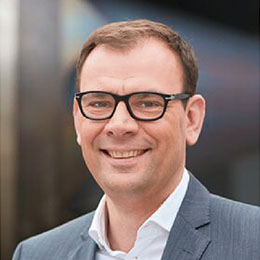
Martin Leutke
Head of Digital Communication
and Media Relations
Lufthansa Group  +49 69 696-36867 +49 69 696-36867
 martin.leutke@dlh.de martin.leutke@dlh.de
| 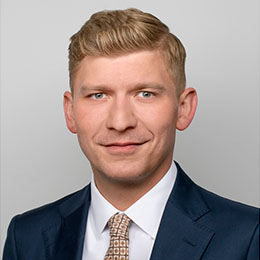
Jan Körner
Head of Government Affairs
Germany and Eastern Europe
Lufthansa Group  +49 30 8875-3212 +49 30 8875-3212
 jan.koerner@dlh.de jan.koerner@dlh.de
|
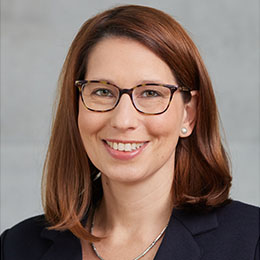
Sandra Courant
Head of Political Communication
and Media Relations Berlin
Lufthansa Group  +49 30 8875-3300 +49 30 8875-3300
 sandra.courant@dlh.de sandra.courant@dlh.de
| 
Jörg Meinke
Head of EU Liaison Office
Lufthansa Group  +32 492 228141 +32 492 228141
 joerg.meinke@dlh.de joerg.meinke@dlh.de
|
| |
| | | | Published by:
Deutsche Lufthansa AG
FRA CI,
Lufthansa Aviation Center
Airportring, D-60546 Frankfurt Andreas Bartels
Head of Communications
Lufthansa Group Dr. Kay Lindemann
Head of Corporate International
Relations and Government Affairs
Lufthansa Group Martin Leutke
Head of Digital Communication
and Media Relations
Lufthansa Group | Editor in Chief:
Sandra Courant
Head of Political Communication
and Media Relations Berlin
Lufthansa Group Editorial Staff:
Hannah-Grace Carter, Alexander Holzrichter, Alexander Lutz, Dr. Christoph Muhle, Jee-Hae Youm Press date:
17 March 2022 Agency Partners:
Köster Kommunikation
GDE | Kommunikation gestalten |
| |
|